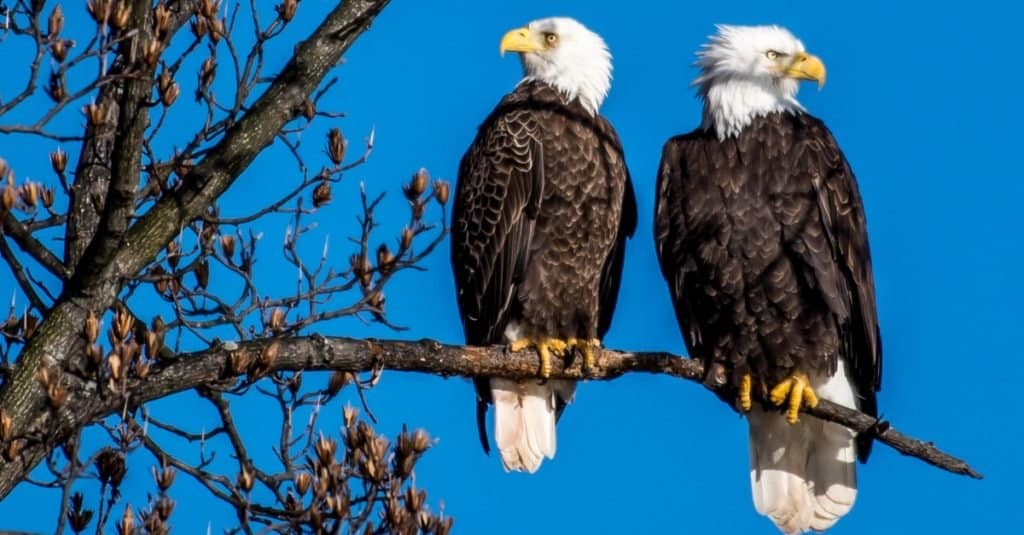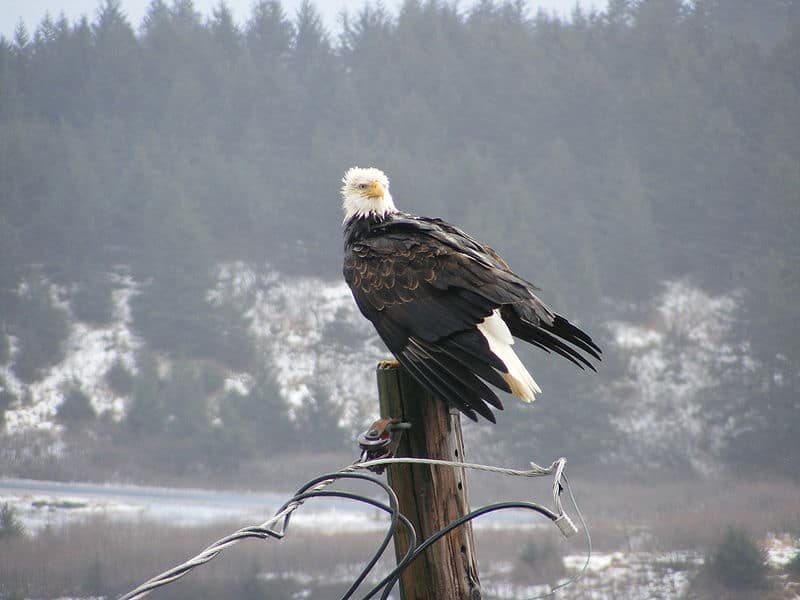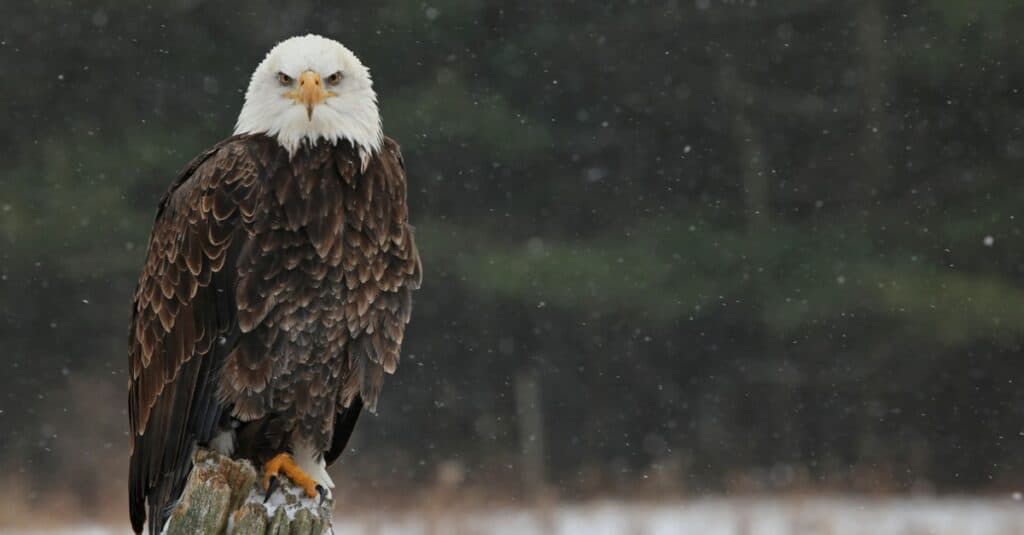Bald eagles are the national symbol for the United States, and not without good reason! They are truly massive birds with a regal look that demands attention. Today, bald eagles can be found across much of North America. Within the species, the males and females have different roles, behaviors, and even some physical differences. Let’s explore what female bald eagles look like and their differences from males.
What do bald eagles look like?

Female bald eagles have the same plumage as males, with no coloration distinctions between the sexes.
©iStock.com/Binkmann
As a species, bald eagles are mainly brown with white heads. Their white heads give them the appearance of a bald crown when they are flying, and the name was originally derived from the older meaning of the word bald, meaning “white-headed.” They can weigh up to 14 lbs and can have wingspans of up to 8 feet, making them some of the largest birds in North America.
Their talons and beak are orange or yellow. Their talons have four claws, three in the front and one in the back. Their beaks are curved and sharp, perfect for grabbing and killing their prey.
What do female bald eagles look like?

Female bald eagles are 35-30% larger than males and are generally more protective.
©Krumpelman Photography/Shutterstock.com
Male and female bald eagles have identical plumage (feathers), making it difficult to identify them from color alone. Aside from color, there are a few ways that can help distinguish the two sexes.
On average, females are 25% larger than males. A male wingspan usually tops 6 feet, while a female can reach lengths of 8 feet. Additionally, females are 5-10 lbs heavier. With this increased size, other subtle differences are also present.
Females have a larger hooked beak and hallux (the back talon on their foot). A female’s vocalizations are slightly different as well, but this isn’t super noticeable to human ears. Generally, females have a lower call and screech when compared to males.
How do female bald eagles behave?
There are a few behavioral differences between male and female bald eagles. Much of that behavioral change is due to their size and subsequent evolutionary advantages.
The females being larger than males is known as reverse sexual size dimorphism. For bald eagles, this adaption is clearly beneficial. The larger size in females serves a few purposes. The first is that it allows them to sit for larger periods of time on the nest when they have eggs. Longer periods without food are easier for larger animals. Additionally, the sheer effect of having a larger defender of the eggs is advantageous.
Males are the hunters in the relationship, and their smaller, sleeker size is better adapted for it. While a female looks over the eggs and the nest, the male is out hunting for the family. Their sexually dimorphic size has allowed both sexes to fulfill particular tasks when it comes to parenting. Since the birds mate for life, the relationship is an important one.
Behaviorally, females can be more dominant and protective. This likely stems from the female’s motherly behavior and is commonly witnessed. A mated pair will generally defend a region of waterside territory that is up to 1.5 square miles.
How often do female bald eagles raise chicks?

Female bald eagles spend more time on the nest than the males, but both share the responsibility of raising the young.
©Mary Lynn Stephenson – Public Domain
Female eagles generally produce 1-3 eggs per year. The size of the eggs increases the further they are from the equator in order to help maintain heat. Additionally, northern bald eagles are bigger than their southern counterparts. The female builds nests in old-growth trees as the male brings in materials. Generally, the female is in charge of placement while the male gets the resources. The nests that bald eagles build are the largest in all of the bird kingdom. Some nests have been weighed up to a metric ton.
Egg incubation is the duty of both parents, but the female generally shares the bulk of the responsibility. While the female incubates, the male will hunt and provide food for both of them. Occasionally, the female will want to go out herself and will call the male back to protect the eggs. A bald spot appears on the chest of both parents to aid in the incubation of the eggs. Within 5-6 weeks of the chicks being born, the parents begin to taper off their time in the nest.
Both parents feed the chicks by tearing pieces of food off and handing it to them. They often overfeed one of the chicks, with one eaglet getting the majority of the resources. A male will catch and kill a fish to feed to the nest. There has been evidence that the male will then eat the head and guts of the fish, getting essential nutrients while at the same time lightening the load when he returns to the nest.
When can female bald eagles have eggs?
A bald eagle becomes sexually mature when they are 4-5 years old. A physical sign of their maturity is their head plumage. Before they are mature, an eagle will be totally brown. At maturity, their heads will turn white, giving them their characteristic look. It’s around the 4-5 year mark that a female bald eagle will look for a mate, usually returning to where they were born.
Do female bald eagles have different mates through life?

Female bald eagles mate for life and perform elaborate bonding rituals.
©iStock.com/ca2hill
Eagles exhibit lifelong monogamy, a rarity among the animal kingdom. This means they when two eagles bond, they bond for life. After bonding, they nest together, hunt for one another, and raise future chicks together.
The bonding ritual of bald eagles is death-defying but beautiful. They will soar high into the air and lock claws. As they plummet to the earth, they hold on until the last second, shooting their wings open and avoiding the ground by mere feet. The practice is then repeated and involves calls and other displays.
Although mating generally lasts for life, the two will separate after repeated failed attempts at breeding. Additionally, some will find other mates if theirs dies. Some instances of a dead mate, however, result in permanent solitary behavior when the remaining mate never looks for a replacement.
The photo featured at the top of this post is © Jon C. Beverly/Shutterstock.com
Thank you for reading! Have some feedback for us? Contact the AZ Animals editorial team.






